Jon A. Kobashigawa, MD
- Associate Director of the Cedars-Sinai Heart Institute
- Director of Advanced Heart Disease and Director of the
- Heart Transplant Program at Cedars-Sinai
- DSL/Thomas D. Gordon Chair in Heart Transplantation
- Medicine, Clinical Professor of Medicine and Cardiology
- at the David Geffen School of Medicine at the University
- of California, Los Angeles (UCLA)
- Los Angeles, California
Cyclophosphamide dosages: 50 mg
Cyclophosphamide packs: 30 pills, 60 pills, 90 pills, 120 pills, 180 pills, 270 pills, 360 pills
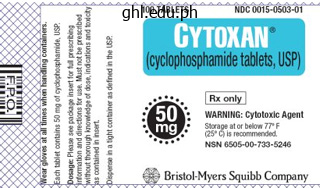
50 mg cyclophosphamide order with mastercard
Macrolides, similar to erythromycin and clindamycin, have usually been really helpful for penicillin-allergic patients and for patients with necrotizing fasciitis. However, resistance to macrolide antibiotics has been increasing in Europe and in the United States. In acute streptococcal infections, nevertheless, each effort should be made to rapidly eradicate streptococci from the patient, eliminate the antigenic stimulus (before day 8), and thus stop poststreptococcal illness. Doses of penicillin or erythromycin that end in effective tissue levels for 10 days normally accomplish this. Antimicrobial drugs are additionally very helpful in stopping reinfection with -hemolytic group A streptococci in sufferers with rheumatic fever. The final supply of group A streptococci is a person harboring these organisms. The particular person could have a scientific or subclinical an infection or could additionally be a service distributing streptococci directly to other persons via droplets from the respiratory tract or pores and skin. Many different streptococci (eg, viridans streptococci and enterococci) are members of the normal microbiota of the human body. To forestall such accidents, notably in the midst of surgical procedures on the respiratory, gastrointestinal, and urinary tracts that result in momentary bacteremia, antimicrobial agents are sometimes administered prophylactically to persons with known coronary heart valve deformity and to these with prosthetic valves or joints. Guidelines revealed by the American Heart Association and different skilled societies have clarified some of these suggestions (see Wilson et al, 2007). Detection and early antimicrobial therapy of respiratory and skin infections with group A streptococci. Prompt eradication of streptococci from early infections can successfully prevent the development of poststreptococcal illness. This requires maintenance of enough penicillin levels in tissues for 10 days (eg, benzathine penicillin G given once intramuscularly). This entails giving one injection of benzathine penicillin G intramuscularly every 3�4 weeks or every day oral penicillin or oral sulfonamide. The first assault of rheumatic fever infrequently causes major coronary heart harm; nevertheless, such persons are particularly susceptible to reinfections with streptococci that precipitate relapses of rheumatic exercise and provides rise to cardiac injury. Chemoprophylaxis in such people, particularly children, should be continued for years. An exception may be household teams with a excessive rate of poststreptococcal nephritis. This is particularly essential when carriers are in areas similar to obstetric supply rooms, working rooms, classrooms, or nurseries. Concept Checks � Streptococci are a big group of Gram-positive organisms which would possibly be catalase negative and have a tendency to develop in pairs and long chains. Major classifications include the type of hemolysis (, or no hemolysis) situations for growth, and capability to cause disease. They sometimes are -hemolytic and produce zones of hemolysis which are only barely bigger than the colonies (1�2 mm in diameter). Group B streptococci are a part of the traditional vaginal flora and lower gastrointestinal tract in 5�30% of girls. Group B streptococcal an infection in the course of the first month of life could present as fulminant sepsis, meningitis, or respiratory distress syndrome. Substantial reductions within the incidence of early-onset neonatal group B streptococcal infections have been observed after the 1996 suggestions for screening pregnant women at 35�37 weeks of being pregnant. This is done through the use of both broth-enriched culture or molecular methods on rectal and vaginal swabs obtained at the time of screening. Two increasing populations, particularly elderly adults and immunocompromised hosts, are most at risk for invasive illness. Bacteremia, pores and skin and gentle tissue infections, respiratory infections, and genitourinary infections in descending order of frequency are the major clinical manifestations. Groups C and G streptococci have hemolysins and will have M proteins analogous to these of group A S. One of the multiple species of group G streptococci, Streptococcus canis, can cause pores and skin infections of canines however uncommonly infects humans; other species of group G streptococci infect people.
Cyclophosphamide 50 mg cheap visa
The cytoplasmic membrane of bacteria and fungi has a structure different from that of animal cells and could be extra readily disrupted by certain brokers. Detergents, which comprise lipophilic and hydrophilic groups, disrupt cytoplasmic membranes and kill the cell (see Chapter 4). One class of antibiotics, the polymyxins, consists of detergent-like cyclic peptides that selectively damage membranes containing phosphatidylethanolamine, a serious element of bacterial membranes. They could interfere with formation of initiation complexes for peptide chain synthesis or could intrude with aminoacyl translocation reactions. The erm (erythromycin ribosome methylation) genes that encode this mechanism could also be underneath plasmid or chromosomal management. They may be expressed constitutively or could also be induced by subinhibitory concentrations of macrolides. Other less widespread mechanisms of resistance include manufacturing of inactivating enzymes or mef- and msr-encoded efflux. The subunits of every type of ribosome, their chemical composition, and their functional specificities are sufficiently different to explain why antimicrobial medicine can inhibit protein synthesis in bacterial ribosomes with out having a significant effect on mammalian ribosomes. Lincosamides Clindamycin and lincomycin bind to the 50S subunit of the microbial ribosome and resemble macrolides in binding web site, antibacterial exercise, and mode of motion. Chromosomal mutants are resistant because they lack the correct binding web site on the 50S subunit. Aminoglycosides the mode of action of streptomycin has been studied way more intensively than that of different aminoglycosides, but all act equally. The first step is the attachment of the aminoglycoside to a selected receptor protein (P 12 in the case of streptomycin) on the 30S subunit of the microbial ribosome. Fourth, aminoglycoside attachment results in the breakup of polysomes and their separation into monosomes incapable of protein synthesis. These actions happen roughly concurrently, and the general impact is normally an irreversible event-killing of the bacterium. Chromosomal resistance of microbes to aminoglycosides principally is dependent upon the dearth of a selected protein receptor (modification of the goal site attributable to mutations) on the 30S subunit of the ribosome. Plasmid-dependent resistance to aminoglycosides depends on the production by the microorganism of adenylating, phosphorylating, or acetylating enzymes that destroy the drugs (most frequent mechanism). Tetracyclines Tetracyclines bind reversibly to the 30S subunit of microbial ribosomes. Resistance to tetracyclines happens by a number of mechanisms-efflux, ribosomal protection proteins, and chemical modification, amongst others. The first two are the most important and occur as follows: Efflux pumps, situated within the bacterial cell cytoplasmic membrane, are liable for pumping the drug out of the cell. Tet gene merchandise are liable for defending the ribosome, doubtless through mechanisms that induce conformational modifications. These conformational modifications both stop binding of the tetracyclines or trigger their dissociation from the ribosome. The glycylcyclines inhibit protein synthesis in a manner much like the tetracyclines however they demonstrate more avid binding to the ribosome. This drug has approved indications for treatment of pores and skin and skin structure infections, in intra-abdominal infections and for the remedy of community-acquired pneumonia, particularly those attributable to bacterial pathogens proof against a big selection of other antimicrobial agents. In addition, use of this drug for treatment of multidrug-resistant health care-associated infections (except P. It interferes with the binding of recent amino acids to the nascent peptide chain, largely because chloramphenicol inhibits peptidyl transferase. Chloramphenicol is principally bacteriostatic, and progress of microorganisms resumes when the drug is withdrawn. Microorganisms resistant to chloramphenicol normally produce the chloramphenicol acetyltransferases, which destroys drug activity. The manufacturing of this enzyme is often under the management of plasmid-mediated resistance genes known as cat genes. Other mechanisms of resistance embrace efflux pumps and decreased membrane permeability. These two brokers act synergistically to obtain bactericidal activity against Gram-positive bacteria not seen with both agent alone. The mechanism of motion seems to be irreversible binding to completely different websites on the 50S subunits of the 70S bacterial ribosomes. Resistance might occur from conformational modifications in the goal, efflux, and enzymatic inactivation.
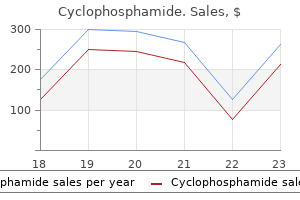
Discount cyclophosphamide 50 mg with visa
Universal System of Virus Taxonomy A system has been established during which viruses are separated into main groupings-called families-on the basis of virion morphology, genome construction, and techniques of replication. Within each household, subdivisions referred to as genera are usually based on biological, genomic, physicochemical, or serologic variations. The genus Orthopoxvirus, which incorporates the better-studied poxviruses (eg, vaccinia), is ether resistant; a few of the poxviruses belonging to other genera are ether delicate. Reoviridae, Retroviridae), a larger grouping called subfamilies has been defined, reflecting the complexity of relationships among member viruses. Virus orders could additionally be used to group virus households that share widespread characteristics. For instance, order Mononegavirales encompasses the Bornaviridae, Filoviridae, Paramyxoviridae, and Rhabdoviridae households. As of 2017, the International Committee on Taxonomy of Viruses had organized greater than 4400 virus species into 122 households and 735 genera. Properties of the major families of animal viruses that contain members necessary in human disease are summarized in Table 29-1. Only these households that embrace human pathogens are listed in Table 29-1 and described within the textual content. Parvoviridae Parvoviruses (from Latin parvus which means small) are very small viruses with a particle dimension of about 18�26 nm. Replication occurs only in actively dividing cells; capsid meeting takes place in the nucleus of the contaminated cell. Human parvovirus B19 replicates in immature erythroid cells and causes a quantity of opposed consequences, together with aplastic disaster, fifth illness, and fetal demise (see Chapter 31). At least sixty seven types infect humans, particularly in mucous membranes, and a few types can persist in lymphoid tissue. Adenoviruses may cause acute respiratory diseases, conjunctivitis, and gastroenteritis. The virus consists of a 27-nm icosahedral nucleocapsid core inside a intently adherent envelope that incorporates lipid and the viral floor antigen. The surface protein is characteristically overproduced during replication of the virus, which takes place in the liver, and is shed into the bloodstream. Hepadnaviruses similar to Hepatitis B virus can cause acute and chronic hepatitis; persistent infections are associated with a excessive danger of growing liver cancer. Anelloviridae Anelloviruses (from Latin anello which means ring) are small (~30 nm in diameter), icosahedral virions that lack an envelope. Anelloviruses embrace the torque teno viruses, and are globally distributed within the human inhabitants and heaps of animal species. Polyomaviridae Polyomaviruses are small (45 nm), nonenveloped, heat-stable, solubilization-resistant viruses exhibiting cubic symmetry, with seventy two capsomeres. The name derives from Greek poly(many) and �oma (tumor) and refers to the ability of a few of these viruses to produce tumors in contaminated hosts. Most animal species harbor chronic infections with a number of polyomaviruses (see Chapter 43). The name refers to Latin herpes (creep), describing the spreading nature of skin lesions attributable to these viruses. The nucleocapsid is one hundred nm in diameter, with cubic symmetry and 162 capsomeres, surrounded by a lipidcontaining envelope. Latent infections might last for the life span of the host, usually in ganglial or lymphoblastoid cells. Human herpesviruses include herpes simplex varieties 1 and a pair of (oral and genital lesions), varicella-zoster virus (chickenpox and shingles), cytomegalovirus, Epstein-Barr virus (infectious mononucleosis and association with human neoplasms), human herpesviruses 6 and seven (T cell lymphotropic), and human herpesvirus 8 (associated with Kaposi sarcoma). Papillomaviridae Papillomaviruses are much like polyomaviruses in some respects however with a larger genome (8 kb) and particle measurement (55�60 nm). The name refers to Latin papilla (nipple) and Greek �oma (tumor) and describes wart-like lesions produced by these viral infections. There are many kinds of human papillomaviruses, and sure high-risk varieties are causative agents of genital cancers in humans (see Chapter 43).
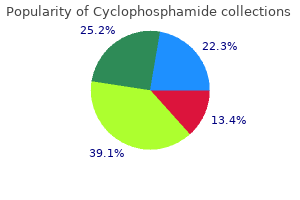
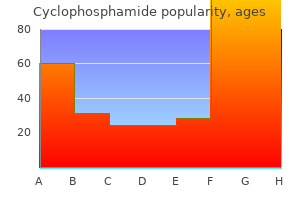
Cyclophosphamide 50 mg with visa
Matte colonies consist of organisms that produce a lot M protein and usually are virulent. It transforms the plasminogen of human plasma into plasmin, an active proteolytic enzyme that digests fibrin and different proteins, permitting the micro organism to escape from blood clots. This means of digestion could additionally be interfered with by nonspecific serum inhibitors and by a particular antibody, antistreptokinase. Streptokinase has been given intravenously for treatment of pulmonary emboli, coronary artery, and venous thromboses. M protein is a filamentous structure anchored to the cell membrane that penetrates and projects from the streptococcal cell wall. Immunity to an infection with group A streptococci is expounded to the presence of type-specific antibodies to M protein. Because there are more than 150 kinds of M protein, an individual can have repeated infections with S. Both teams C and G streptococci have genes homologous to the genes for M protein of group A, and M proteins much like those of group A have been discovered on teams C and G streptococci. The M protein molecule has a rodlike coiled construction that separates practical domains. The structure allows for a giant number of sequence modifications whereas maintaining perform, and the M protein immunodeterminants, due to this fact, can readily change. Hyaluronidase Hyaluronidase splits hyaluronic acid, an essential element of the ground substance of connective tissue. Thus, hyaluronidase aids in spreading infecting microorganisms (spreading factor). After an infection with hyaluronidase-producing organisms, specific antibodies are found in the serum. There are three antigenically distinct streptococcal pyrogenic exotoxins (Spe): A, B, and C. The streptococcal pyrogenic exotoxins have been associated with streptococcal toxic shock syndrome and scarlet fever. Most strains of group A streptococci isolated from patients with streptococcal toxic shock syndrome both produce Spe A or have the gene that codes for it; in contrast, only about 15% of group A streptococci isolated from other patients have the gene. The group A streptococci related to toxic shock syndrome are primarily of M protein varieties 1 and three. The mechanisms of action seem to be similar to those brought on by staphylococcal toxic shock syndrome toxin-1 and the staphylococcal enterotoxins. The Streptococci, Enterococci, and Related Genera 219 spreading infection that entails the tissues and extends along lymphatic pathways with solely minimal native suppuration. There is very large brawny edema and a rapidly advancing, sharply demarcated margin of an infection. Cellulitis-Streptococcal cellulitis is an acute, quickly spreading infection of the skin and subcutaneous tissues. It follows infection related to delicate trauma, burns, wounds, or surgical incisions. Necrotizing fasciitis (streptococcal gangrene)-There is in depth and really rapidly spreading necrosis of the skin, tissues, and fascia. The group A streptococci that cause necrotizing fasciitis have sometimes been termed flesh-eating micro organism. Puerperal fever-If the streptococci enter the uterus after supply, puerperal fever develops, which is essentially a septicemia originating in the contaminated wound (endometritis). Bacteremia or sepsis-Infection of traumatic or surgical wounds with streptococci ends in bacteremia, which may quickly be fatal. Streptolysin O is answerable for a variety of the hemolysis seen when development happens in cuts made deep into the medium in blood agar plates. Streptolysin S is the agent liable for the hemolytic zones around streptococcal colonies growing on the floor of blood agar plates. In infants and babies, the sore throat happens as a subacute nasopharyngitis with a thin serous discharge and little fever but with an inclination of the an infection to prolong to the middle ear and the mastoid.
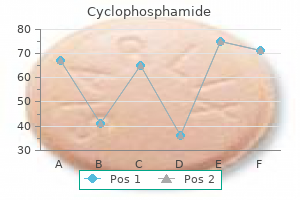
Order cyclophosphamide 50 mg without prescription
Vaccine development is troublesome as a result of a vaccine must present protection in opposition to all 4 serotypes of virus. Therapeutic antibodies able to neutralize multiple genotypes of dengue are additionally underneath improvement. Control is dependent upon antimosquito measures, including elimination of breeding locations and the use of insecticides. Several member viruses produce mosquito-borne encephalitides of people and animals; others cause hemorrhagic fevers. The California encephalitis virus complex comprises 14 antigenically related viruses in the Orthobunyavirus genus of the household. This contains La Crosse virus, a big human pathogen in the United States (see Table 38-2). La Crosse virus is a significant explanation for encephalitis and aseptic meningitis in children, significantly in the upper Midwest. Most instances occur between July and September in kids younger than the age of sixteen years. The viruses are transmitted by numerous woodland mosquitoes, primarily Aedes triseriatus. Principal vertebrate hosts are small mammals corresponding to squirrels, chipmunks, and rabbits. The virus is transmitted transovarially, and adult mosquitoes that develop from infected eggs can transmit the virus by bite. The onset of California encephalitis viral an infection is abrupt, usually with severe headache, fever, and in some cases vomiting and convulsions. Arthropod-Borne and Rodent-Borne Viral Diseases 571 begins abruptly after an incubation period of 3�6 days. Clinical options encompass headache, malaise, nausea, fever, photophobia, stiffness of the neck and back, abdominal ache, and leukopenia. Prevention of illness in endemic areas relies on use of insect repellents in the course of the night time and residual pesticides around dwelling quarters. Humans are secondarily contaminated during the course of epizootics in domesticated animals. Epizootics occur periodically after heavy rains that permit hatches of the primary vector and reservoir (Aedes species mosquitoes). Viremia in animals leads to an infection of other vectors with collateral transmission to humans. Transmission to humans is primarily by contact with infected animal blood and body fluids and mosquito bites. The first documented spread of Rift Valley fever virus outdoors of Africa occurred in 2000 in Yemen and Saudi Arabia. Sandfly fever (also called Phlebotomus fever) is caused by a bunyavirus within the Phlebovirus genus (see Table 38-1). The disease is transmitted by the female sandfly, Phlebotomus papatasi, a midge just a few millimeters in measurement. In the tropics, the sandfly is prevalent all yr; in cooler climates, solely through the warm seasons. When nonimmune adults (eg, troops) arrive, massive outbreaks can happen among the new arrivals and are sometimes mistaken for malaria. In humans, the chunk of the sandfly leads to small itching papules on the skin that persist for as much as 5 days. The illness presents with fever, thrombocytopenia, leukopenia, and elevated liver enzymes. Humans are hardly ever seropositive, however domesticated animals are sometimes seropositive, together with sheep, cattle, pigs, canines, chickens, and up to 80% of goats. Eight human cases have been identified in Missouri and Tennessee, with one case fatality. Patients introduced with fever, fatigue, anorexia, nausea, or diarrhea and had leukopenia, thrombocytopenia, and elevated liver enzymes. Another associated Phlebovirus, Lone Star virus, has been recovered from Lone Star ticks and might infect human cell strains, however no human circumstances have been reported.
Buy cyclophosphamide 50 mg
After several cycles of chemotherapy, the affected person was found to have a high resting pulse price. An grownup affected person is being handled for acute leukemia with a combination of anticancer medicine that includes cyclophosphamide, mercaptopurine, methotrexate, vincristine, and prednisone. He can additionally be utilizing ondansetron for emesis, a chlorhexidine mouthwash to cut back mucositis, and laxatives. The patient complains of "pins and needle" sensations within the extremities and muscle weak point. If these issues are associated to the chemotherapy, which of the following is the most probably causative agent If these problems are because of the anticancer medication to which he has been uncovered, which of the following is the most probably causative agent All the following brokers have been used in drug regimens for the remedy of breast carcinoma. If allopurinol is used adjunctively in most cancers chemotherapy to offset hyperuricemia, the dosage of this anticancer drug must be decreased to 25% of regular. Although myelosuppression is dose limiting, the drug may also trigger cerebellar dysfunction, including ataxia and dysarthria. This metabolite varieties a covalently bound ternary complex with thymidylate synthase and its coenzyme N-methylenetetrahydrofolate. Mesna, a sulfur-containing substance that additionally concentrates in urine, may be administered in an try to prevent this complication. A excessive resting pulse fee is among the first signs of cardiotoxicity resulting from anthracyclines, which can embrace arrhythmias, cardiomyopathies, and coronary heart failure. The danger of cardiotoxicity is dependent upon cumulative dosage, so doxorubicin ought to be discontinued. Bortezomib is an inhibitor of the proteasome construction, whose normal perform is to break down ubiquitinated proteins. In its mildest form, paresthesias occur, however it progresses to significant muscle weak spot, initially in the quadriceps muscle group. Renal toxicity could be reduced by sluggish intravenous infusion, upkeep of excellent hydration, and administration of mannitol to maximize urine flow. For testicular most cancers, cisplatin is utilized in combination with etoposide and bleomycin. Cancer cells acquire resistance to multiple medicine that act through completely different mechanisms by increasing the expressions of genes encoding these transporters. The anticancer drug most commonly associated with pulmonary toxicity is bleomycin. Each of the medication listed has been used in drug regimens for breast most cancers, however only trastuzumab has specificity in its actions. Allopurinol, a xanthine oxidase inhibitor, is given to management the hyperuricemia that occurs because of giant cell kills within the successful drug remedy of malignant ailments. The antimetabolite mercaptopurine is metabolized by xanthine oxidase and, within the presence of an inhibitor of this enzyme (eg, allopurinol); poisonous ranges of the drug could also be reached quickly. The pyrimidine antimetabolite cytarabine (Ara-C) is often used in drug regimens for the acute leukemias. Cerebellar dysfunction may also occur with Ara-C, particularly if the drug is used at excessive doses. Erythropoietin stimulates pink cell formation by interaction with receptors on erythroid progenitors in bone marrow. Name 3 anticancer medication which might be cell cycle-specific and act at different phases of the List the mechanisms by which tumor cells develop drug resistance. Describe the rationale underlying strategies of combination drug chemotherapy and rescue therapies. Identify the most important subclasses of anticancer drugs and describe the mechanisms of action of the principle medicine in each subclass.
Cyclophosphamide 50 mg cheap free shipping
Used in analysis of myasthenia gravis and to distinguish myasthenic crisis from cholinergic crisis. In botanicals (eg, ma huang) and products for weight reduction which are banned in the United States. Drug of alternative in anaphylaxis; used as hemostatic and as adjunct with local anesthetics; cardiac stimulant; traditional use in asthma. Tox: cholestatic jaundice (avoid estolate in pregnancy), inhibits liver drug-metabolizing enzymes, interactions with cisapride, theophylline, warfarin. Other macrolide antibiotics embrace azithromycin (no effect on P450 drug metabolism) and clarithromycin. Used in anemia associated with renal failure and anemias secondary to cancer chemotherapy. Tox: injection site reactions embrace erythema, itching, and swelling; possible elevated rates of an infection and malignancy. Chronic use leads to dependence and dysfunction of multiple organ systems; fetal alcohol syndrome. Used in esophageal and vaginal candidiasis, in coccidioidomycosis, and within the prophylaxis and treatment of fungal meningitis. Used for folic acid deficiency (megaloblastic anemia) and prevention of congenital neural tube defects. Ethacrynic acid is analogous and can be utilized in case of sulfa allergy and causes much less hyperuricemia. Tox: renal dysfunction, ototoxicity; once-daily dosing is efficient (postantibiotic effect) and fewer toxic. Blocks K+ channels in pancreatic B cells, causing depolarization and launch of insulin. Related medicine: glyburide and older sulfonylureas such as chlorpropamide and tolbutamide; short-acting secretagogues embody repaglinide and nateglinide. Tox: cardiovascular and respiratory melancholy and rest of skeletal and easy muscle. Use is declining because of sensitization of heart to catecholamines and occurrence (rare) of hepatitis. Minoxidil, an analogous however extra highly effective antihypertensive, can also be used topically in baldness. Tox: hypersensitivity reactions; increased serum lipids, uric acid, glucose; K+ wasting. Usually reserved for acute inflammation (eg, acute gout), neonatal patent ductus arteriosus. Tox: hepatic dysfunction, inhibits steroid synthesis and P450-dependent drug metabolism. Others: fluconazole, itraconazole, and voriconazole have a wider spectrum and less inhibitory effects on hepatic cytochromes P450. Mechanism of action: activation of nuclear receptors; T4 is converted to T3 in the target cells, the liver, and the kidneys. Other organophosphates: parathion converted to paraoxon, and the nerve gases (eg, sarin, soman). Tox: preliminary growth of extracellular fluid quantity with resulting hyponatremia, headache, nausea. Albendazole (widely used) and thiabendazole (more toxic) are related antihelminthics. Used for prophylaxis against and treatment of chloroquine-resistant malaria, but resistance rising. Strong agonist at � opioid receptors; blocks muscarinic receptors; serotonergic exercise. Tox: restlessness, insomnia, agitation, extrapyramidal results, elevated prolactin. Tox: constipation, emesis, sedation, respiratory depression, miosis, and urinary retention. Tolerance may be marked; excessive potential for psychological and physiologic dependence.
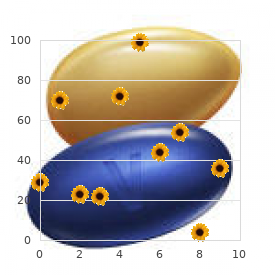
Cyclophosphamide 50 mg visa
Iodoquinol Iodoquinol, a halogenated hydroxyquinoline, is an orally active luminal amebicide used as an alternative to diloxanide for mildto-severe intestinal infections. Adverse gastrointestinal results are widespread but normally mild, especially when taken with meals. Systemic absorption after excessive doses could lead to thyroid enlargement, skin reactions because of iodine toxicity, and possibly neurotoxic effects, including peripheral neuropathy and visual dysfunction. Pharmacokinetics-Metronidazole and tinidazole are efficient orally and distributed broadly to tissues. Mechanism of action-Metronidazole undergoes a reductive bioactivation of its nitro group by ferredoxin (present in anaerobic parasites) to kind reactive cytotoxic merchandise. Clinical use-Metronidazole or tinidazole is the drug of choice in severe intestinal wall illness and in hepatic abscess and different extraintestinal amebic illness. The period of remedy required with metronidazole is longer than with tinidazole. Metronidazole is the drug of choice for trichomoniasis; tinidazole may be effective towards some metronidazole-resistant organisms. Other medical makes use of of metronidazole embrace therapy of giardiasis (tinidazole is equally effective), and infections brought on by Gardnerella vaginalis and anaerobic micro organism (B fragilis, C difficile). Metronidazole is also used in combination regimens for gastrointestinal ulcers associated with H pylori. Toxicity-Adverse effects of metronidazole embody gastrointestinal irritation (it is greatest taken with meals), headache, paresthesias, and darkish coloration of urine. Tinidazole has an identical antagonistic effect profile, but may be better tolerated than metronidazole. Safety of metronidazole and tinidazole in being pregnant and in nursing mothers has not been established. Paromomycin this drug is an aminoglycoside antibiotic used as a luminal amebicide and may be superior to diloxanide in asymptomatic infection. Systemic absorption in renal insufficiency might result in headaches, dizziness, rashes, and arthralgia. Tetracyclines (eg, doxycycline) are sometimes used with a luminal amebicide in mild intestinal disease. Nitazoxanide this agent has activity towards varied protozoans (including Entamoeba) and helminths. Nitazoxanide appears to have exercise against metronidazole-resistant protozoal strains. Oral remedy with the double-strength formulation three occasions weekly is often effective. Toxicity contains gastrointestinal distress, rash, fever, neutropenia, and thrombocytopenia. Preferential accumulation of the drug by prone parasites may account for its selective toxicity. Toxicity-Severe antagonistic effects comply with parenteral use, including respiratory stimulation adopted by depression, hypotension ensuing from peripheral vasodilation, hypoglycemia, anemia, neutropenia, hepatitis, and pancreatitis. Pyrimethamine plus clindamycin (or sulfadiazine) is a routine of alternative for prophylaxis towards and remedy of toxoplasmosis. For treatment of lively toxoplasmosis, the drug combination is given day by day for 3�4 weeks, with folinic acid to offset hematologic toxicity. Toxicity-High doses of pyrimethamine plus sulfadiazine are related to gastric irritation, glossitis, neurologic signs (headache, insomnia, tremors, seizures), and hematotoxicity (megaloblastic anemia, thrombocytopenia). Mechanism and pharmacokinetics-Atovaquone inhibits mitochondrial electron transport and doubtless folate metabolism. Clinical use and toxicity-Atovaquone is accredited to be used in gentle to average pneumocystis pneumonia. Common adverse results are rash, cough, nausea, vomiting, diarrhea, fever, and irregular liver function exams. The drug should be averted in patients with a historical past of cardiac conduction defects, psychiatric disorders, or seizures.
Nemrok, 45 years: Progeny produced as a consequence of nongenetic interaction are similar to the parental viruses. A 31-year-old premenopausal woman has been using a combined oral contraceptive for 10 years.
Goran, 37 years: Genetic and environmental factors are believed to be important in the growth of nasopharyngeal carcinoma. In endemic areas, the inhabitants could construct up immunity because of inapparent infections; the proportion of individuals with antibodies to the local arthropod-borne virus increases with age.
Peer, 41 years: Exfoliative toxin A is encoded by eta located on a phage and is heat steady (resists boiling for 20 minutes). Latent infections are these during which the virus persists in an occult (hidden or cryptic) type more typically than not when no new virus is produced.
Volkar, 40 years: Argatroban (direct thrombin inhibitor) is the drug of selection for quick anticoagulation in patients with heparin-induced thrombocytopenia. Hepatitis A virus was initially categorised as enterovirus sort 72 however is now assigned to a separate genus.
Copper, 51 years: Containment and disinfection of dirty areas and bedding may help decrease viral spread. Because of inhibitory substances in blood, just one or two drops ought to be positioned in every of five tubes containing 5 or 10 mL of medium.
Koraz, 32 years: H (14) the action potential has a markedly slowed upstroke and extended duration. A semiconscious patient in the intensive care unit is being artificially ventilated.
Ford, 50 years: The reason for death of infants with disseminated disease is usually viral pneumonitis or intravascular coagulopathy. Meningococcal antigens are present in blood and cerebrospinal fluid of patients with energetic disease.
Kippler, 23 years: Endocervical specimens must be collected after removing of discharge and secretions from the cervix. In pneumonia, sputum is cultured; in potential meningitis, cerebrospinal fluid is taken for smear and culture.
Grim, 25 years: Recurrences are uncommon and happen years later, usually following the distribution of a peripheral nerve (shingles). It is the smallest of known human pathogens and resembles subviral plant pathogens (ie, viroids).
Daryl, 59 years: The pharmacologic properties of tobramycin are just about similar to these of gentamicin. Transmission from carriers to shut contacts by the oral route or by sexual or different intimate publicity happens.
Sanford, 31 years: Poliovirus invades certain forms of nerve cells, and in the strategy of its intracellular multiplication, it might harm or utterly destroy these cells. Flagella-mediated motility then permits the organisms, protected against the gastric acid, to transfer via the gastric mucus toward the epithelium.
8 of 10 - Review by L. Murak
Votes: 142 votes
Total customer reviews: 142
References
- Ottenbacher, K.J., & Maas, F. (1999). How to detect effects: Statistical power and evidence-based practice in occupational therapy research. American Journal of Occupational Therapy, 53(2), 181n188.
- Gandy SJ, Armoogum K, et al. A clinical MRI investigation of the relationship between kidney volume measurements and renal function in patients with renovascular disease. Br J Radiol 2007; 80:12.
- Chen K, Craig JC, Shumack S. Oral retinoids for the prevention of skin cancers in solid organ transplant recipients: a systematic review of randomized controlled trials. Br J Dermatol 2005;152:518-523.
- Rindi G, Azzoni C, La Rosa S, et al. ECL cell tumor and poorly differentiated endocrine carcinoma of the stomach: prognostic evaluation by pathological analysis. Gastroenterology 1999;116: 532.
- Seller RH, Cangiano J, Kim KE, et al: Digitalis toxicity and hypomagnesemia, Am Heart J 79:57, 1970.
- Bachmann F, Kruithof IE. Tissue plasminogen activator: Chemical and physiological aspects. Semin Thromb Hemost 1984; 10:6-17.
- Rosner MH, Okusa MD. Acute kidney injury associated with cardiac surgery. Clin J Am Soc Nephrol. 2006;1(1):19-32.


